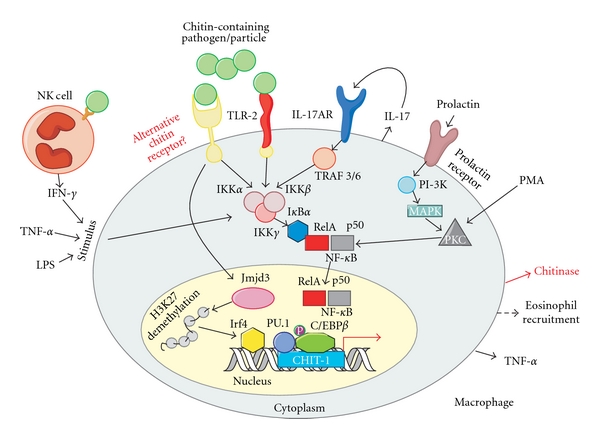Figure 3.

Hypothetical model for a molecular chitinase response to chitin-containing pathogens or particles. Chitin recognition leads to the expression of chitinase, TNF-α, IL-17, and eosinophil recruitment [83, 84]. NF-κB serves as the primary signaling pathway involved in the recognition of most fungal cell wall components (see Figure 2) [45]; therefore, its involvement in the expression of chitinase in response to a chitin-containing pathogen or particle is highly likely. Secretion of IFN-γ by NK cells induces macrophage priming caused by stimulation with a chitin-containing pathogen or particle [60–63]. IFN-γ, LPS, TNF-α, and PMA up-regulate chitinase activity [16–19], possibly through an NF-κB inflammatory-mediated pathway. IL-17 secretion upon macrophage stimulation with chitin increased levels of IL-17-AR and was TLR-2 dependent [84]. Either TLR-2 or an alternative chitin-specific receptor may recognize chitin-containing pathogens or particles and mediate chitinase activity. Prolactin stimulation of macrophages leads to chitinase expression via a PI-3K, MAPK, and NF-κB pathway [16–19]. Activation of Jmjd3, leads to demethylation of H3K27 and recruitment of the transcription factor Irf4, which is associated with M2 macrophage polarization in response to chitin stimulation [59]. Expression of the chitinase encoded by the CHIT-1 gene is regulated via PU.1 and C/EBPβ. The latter is phosphorylated (p) to induce CHIT-1 expression [85]. NF-κB, nuclear factor kappa-light-chain-enhancer of activated B cells; IFN-γ: interferon gamma; NK cells: natural killer cells; LPS: lipopolysaccharide; TNF-α: tumor necrosis factor alpha; PMA: phorbol 12-myristate 13-acetate; IL-17: interleukin-17; IL-17-AR: interleukin-17A receptor; TLR-2: toll-like receptor-2; PI-3K: phosphatidylinositol 3-kinase; MAPK: Mitogen-activated protein kinase; Jmjd3: Jumonji domain containing-3; H3K27: histone 3 Lys27 demethylase; CHIT-1: chitotriosidase; C/EBPβ: CCAAT-enhancer-binding protein beta.
